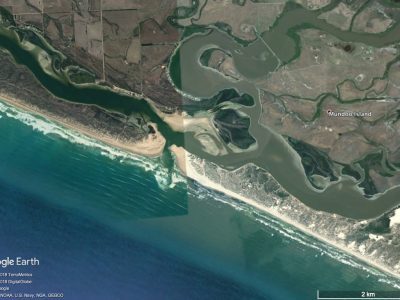PROGNOSIS FOR A CHOKING MOUTH: THE RIVER MURRAY

Some of the world’s major rivers no longer flow to the ocean. They begin to die from the mouth upwards. Extraction of river water for irrigation has dramatically affected the Colorado in the USA, and the Yellow River in China. In between Uzbekistan and Kazakhstan, the drying up of the former inland Aral Sea is an environmental disaster.
Australia’s Murray-Darling Basin (MDB) is a large river basin by world standards, but even with management lessons from overseas river basins the River Murray mouth is being choked with marine sand.
Our recent contributions to a paper on the role of coastal processes in the management of the mouth of the River Murray highlights the apparent problem of getting a balanced perspective on the relative importance of fluvial and coastal processes at the estuarine end of a river system.
Our paper was deliberately published in River Research and Applications (DOI: 10.1002/rra.3551). Plans designed to sustain the health and well-being of the MDB, including its estuary and river mouth, focused on hydrological modelling with little consideration to the role of waves and nearshore processes in the vicinity of the river entrance. This may seem trivial relative to the size of the catchment and its environmental, social, and economic problems, but the Water Act and the Murray-Darling Basin Plan set out specific targets considered to be required to achieve a healthy end-of-system. There are clearly major problems in achieving those targets. The current band-aid solution is to spend a not insignificant sum of ~$6-7 million each year to dredge the Murray Mouth.
In our paper we note that many large river systems face a range of major issues, including water security, maintaining biodiversity, impacts of flow regulation, over-extraction, and governance. In addition, effects of climate change such as sea-level rise, are an issue in developing future management plans. Over-extraction of freshwater in the MDB became of sufficient importance for the Australian Government to promulgate the Water Act 2007 thereby initiating the MDB Plan. Targets in the Act and Plan include length of time that water should be allowed to flow to the sea, the need to flush salt out of the Lower Lakes, and maintenance of a lake level to retain their freshwater condition behind the barrages located near the river mouth. These targets were largely based on hydrological models following a range of assumptions, none of which considered the role of the sea.
In preparing our paper we were surprised by: (1) the neglect of the published literature on the geomorphology of the river mouth and its environs both seaward, alongshore and into the floodtide delta; and (2) the apparent failure to consider quite a few reports commissioned by the South Australian Government over several decades that relate to river mouth dynamics. For example, the well-recognised term ‘floodtide delta’ appears absent from recent government reviews and plans for the lower end of the system yet these refer to the less important (in terms of low) fluvial delta in Lake Alexandrina. This indicates an imbalance and perhaps misunderstanding of the importance of coastal processes for management of the estuary.
Since barrages were completed in the early 1940s river flows have been insufficient to prevent extensive growth of the floodtide delta. Progressive choking of sand ingress into the mouth has led to dredging. However, the MDB Plan requires that that there will be sufficient river flows for the mouth to be open 95% of the time without dredging. However, the opposite is the case. We envisage more sand transport into the mouth as sea level continues to rise given the nature of the wave climate on this high energy coast. Our paper outlines why this will happen and argues for revision of those aspects of the Plan dependent simply on freshwater discharge to maintain an open mouth.
The disconnect in understanding the interplay of coastal and fluvial processes in estuaries as seen in this case is not unique. We have seen in Australia and elsewhere how difficult it is to interact in both field and modelling studies. Often coastal scientists meet separately and communicate through different forums. Even the very existence of ACS is testimony to scientists, managers, conservationists, and others wanting to provide a more integrated communication network. This should not be a problem except when you get examples such as we have experienced in the Murray Mouth where governments are fed information that bypasses an existing knowledge base that is important to decision-makers.
Thom, B, Rocheta, E, Steinfeld, C, Harvey, N, Pittock, J, Cowell, P. The role of coastal processes in the management of the mouth of the River Murray, Australia: Present and future challenges. River Res Applic. 2020; 36: 656– 667. https://doi.org/10.1002/rra.3551
Murray-Darling Basin Plan 2012: https://www.legislation.gov.au/Details/F2020C00074
Water Act 2007: https://www.legislation.gov.au/Details/C2020C00058
Bruce Thom and Nick Harvey
Words by Prof Bruce Thom and Prof Nick Harvey. Please respect the authors’ thoughts and reference appropriately: (c) ACS, 2020, for correspondence about this blog post please email austcoastsoc@gmail.com
#164


 Geomorphologic Mapping
Geomorphologic Mapping